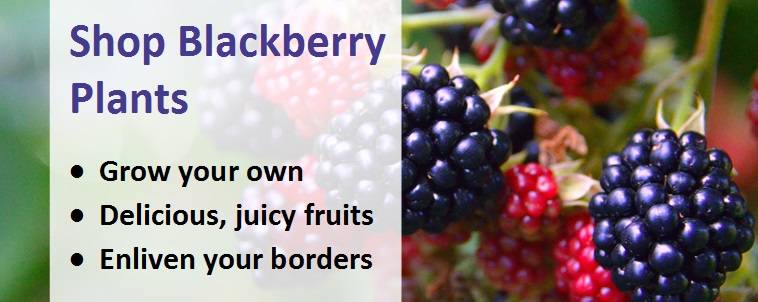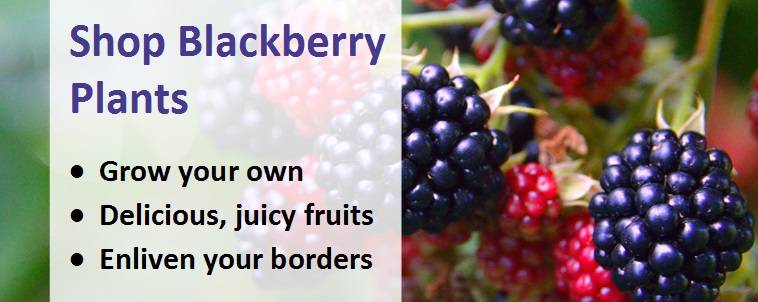How to Grow Your Own Blackberries
Blackberry plants are easy-to-grow, pest and disease resistant and require less space than loganberries, making them suitable for smaller gardens. They can be trained a variety of ways - making an attractive display over a pergola or arch; grown as a fan against a wall; or even kept in a container on the patio. Blackberries can be grown for the ornamental value of their flowers, which appear late escaping the frost, as well as fruit. Attractive, dainty white flowers, subtly flushed pale pink with large golden centres appear on one year old canes in spring before the fruit. Each blossom then produces a sweet, juicy blackberry ready for picking in late August to late September. The self-fertile nature of blackberry bushes mean they do not need to be grown alongside another blackberry to deliver a bumper crop.
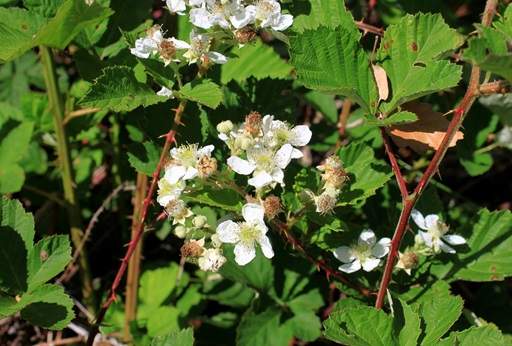
White flowers tinged pale-pink appear before the fruit each spring
Recommended Blackberry Variety
The best blackberry variety is:
Blackberry Oregon Thornless - A popular, highly ornamental deciduous blackberry bearing attractive, white, cup-shaped blooms with large, golden-green centres. It produces heavy crops of mild and juicy fruit on thornless stems from late August to late September. Perfect for training over an arch, trellis or pergola, it has distinctly serrated, dark green, parsley-shaped leaves that take on stunning shades of red during the autumn. A decorative plant that's useful for smaller gardens.
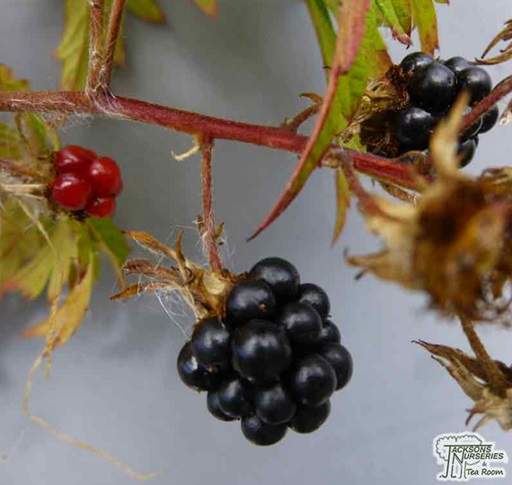
Fruit
Blackberries appear on last year's canes from late summer onwards and are usually ready for picking around August, once the fruits have turned from green to pink-red and then dark purple-black. Fruits are perfectly ripe when they come away from the plant easily; if they don't pull away easily, leave them to ripen for a few more days. Do not pick the red berries; they're unripe and too tart to enjoy. The darkest berries have the maximum sugar content and deliver a highly aromatic, intense flavour. The core to blackberries is part of the edible fruit, unlike raspberries where the core stays on the plant.
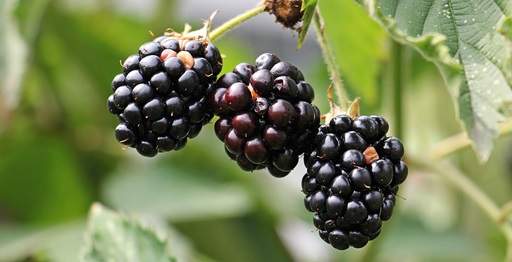
Dark purple-black berries that come away from the bush easily when picked are ready to be harvested
As a rule of thumb, 5 or 6 plants will produce enough berries for a family of four. They can be included in recipes including blackberry cobbler and blackberry pie, or used to make jam. Although fresh fruit is always best, blackberries can be stored by canning, preserving or freezing. Blackberries are very high in ellagic acid which is an antioxidant that makes potential cancer-causing chemicals inactive. Ellagic acid reduces the genetic damage caused by carcinogens like tobacco smoke and air pollution. They also contain other antioxidants that help lower cholesterol and ward off cardiovascular disease.
Planting Advice
Containerised plants can be planted any time except during frosts, although autumn is preferable, whilst bare root blackberries can be planted any time during the dormant season from November to March. The best crop will always be produced when they are situated in a sheltered site in full sun, although they are tolerant of some shade providing the site is not exposed. A moist, yet well-drained soil is preferred, so incorporate a generous amount of organic matter such as leaf mould, well-rotted garden compost, grass clippings or manure when planting, particularly if you have a heavier soil. A slightly acidic soil with pH between 5.5 and 7.0 is ideal.
Blackberry Oregon Thornless has a semi-erect form, so whilst it can be grown as a bush (for example, in a container on the patio), if you choose to plant it in the garden it's best grown somewhere where you can train the canes up a wall or fence, in the shape of a fan, over an archway or even within a T-trellis. Erect a wire frame to support the branches and make picking easier prior to planting, positioning horizontal wires 45cm (18") apart with the lowest wire 23cm (9") from the ground.
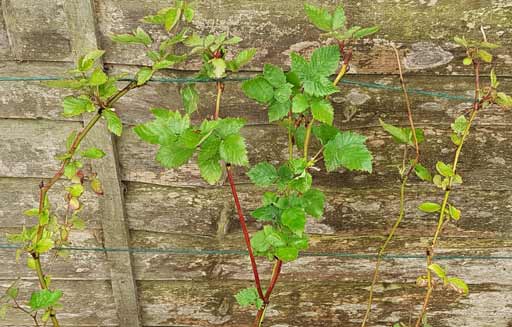
Trained blackberry on supports
Blackberry Plant Care
Apply a general purpose fertiliser in mid-spring to boost growth and mulch annually, ensuring that mulch does not touch new canes to prevent the crown from rotting, to help conserve moisture and suffocate weeds. Ensure that the area around the blackberry is kept well-weeded and water weekly during periods of prolonged dry weather. It's a good idea to dig lightly under the canes in winter to uncover pests such as raspberry beetle larvae (which also attach blackberries) so, if you're lucky, birds will eat them away.
Blackberries are tolerant of pruning; cutting back regularly and with vigour using bypass secateurs is vital to keeping your plant healthy and helping it to produce the best crop possible. Blackberries have a bi-annual cane system - the current season's stems are called primocanes which sprout from the rootstock from midsummer and will not bear fruit or flowers until the following year; whilst last season's stems are called floricanes and will bear fruit and flowers in the current year. Cut most floricanes and older canes right back to ground level each winter, leaving 6-8 newer canes per plant. Cutting back one-year old canes that have fruited encourages the plant to focus all its remaining energy into producing a bigger berry on what will be the one-year old fruiting canes the following year. In fact, the most likely cause of small, low quality berries is lack of sufficient pruning the previous winter. Removing older canes has the added benefit of preventing your plants from being affected by pests and diseases.
Finally, tip prune primocanes during late summer to encourage the development of new lateral shoots. Removing the top 1-2 inches of the new canes when they are 1.2m (4 feet) tall will encourage branching, increasing next year's yields. Some people prefer to separate out primocanes from floricanes and older canes using bamboo and string/twine, to ensure that floricanes and older canes are pruned back in the winter and primocanes (that will fruit next year) have their tips removed only, rather than being completely removed.
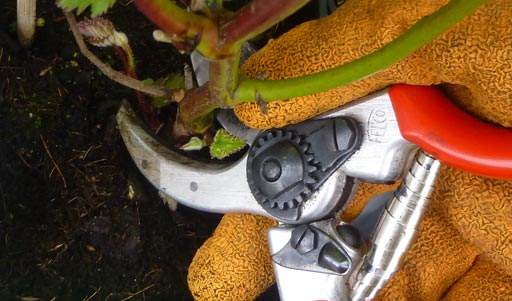
Cut back most one-year old canes that have just fruited in winter, leaving 6-8 newer canes
Share this page:

